Party Games for your Horse – Blog 11
“Fetch! Apport!”
|
|
Kleine Gesellschaftsspiele für Ihr Pferd – Teil 11
“Apport !!”
|
- “Fetching” is a game, which can be lots of fun, but should be contemplated with caution. When a horse “fetches” an object, he has to grab it with his teeth, and not every horse is naturally gentle in this.
- The great advantage of this game is that it makes your horse curious and happy – and therefore confident. The disadvantage might be that it becomes TOO much fun after a while and you might no longer be able to stop the enthusiastic grabbing of whatever object is near …
|
|
- Apportieren ist ein Spiel, das sehr viel Spaß machen kann, muß aber mit ein bißchen Vorsicht genossen werden. Denn wenn ein Pferd einen Gegenstand apportiert, muß es mit den Zähnen zupacken, und dabei ist nicht jedes Pferd immer behutsam.
- Der große Vorteil dieses Spiel ist, daß es Ihr Pferd neugierig und fröhlich macht – und damit eben auch selbstbewußt. Der Nachteil kann sein, daß es Ihrem Pferd nach einer Weile ZU viel Spaß macht, und Sie das wilde Apportieren nicht mehr abstellen können…
|
 With greatest pleasure Johnny fetched all and everything – even his humans…
Johnny apportierte mit größtem Vergnügen alles, sogar seine Menschen…
|
- The horse learns to „fetch“ via clicker training, also called target training. Here I always refer readers to Karen Pryor’s wonderful book „Don’t shoot the dog“, in which she explains in depth how to teach an animal to become interested in target objects. This cannot be repeated here – do read it!
- This training relies on positive reinforcement only, during which a signal (a click or whistle or such) tells the animal instantly that it has done the right thing. When the signal sounds, the exercise is at an end and a treat follows instantly.
- As animals can’t understand our language, they can learn only through association. As soon as my horse touches the proffered object (target), – perhaps by mere coincidence at first – , he hears the click and instantly gets a treat. Every normal horse finds this cool! And he learns very quickly that HE can trigger the click and therefore the food, by touching the object.
- That makes your play-partner very cheerful, since he is the acting partner, as he is making you re-act, because you have to click and feed! Very soon he quite thinks that he is your trainer – and such well-trained humans are of course very agreeable!
- A word command (at first this might be „touch“) may only be introduced once the horse already does the right thing reliably – when the nose is almost touching.
- As soon as possible – as soon as the horse has understood step one and trusts you to fulfil the contract of “click always means treat!”, you make your training variable.
- Although the horse executes the same action, you don’t click anymore! The horse thinks: “what on earth is wrong with my well-trained human now??” – and proceeds to try something else to trigger his treat. This way I can induce him to touch the object longer, or follow it, or seek it out when I just point! This sending on a pointing finger is what we use in this game!
- In order to not disappoint or frustrate your horse, you must increase any difficulty of the exercise in very small increments, so he can always retain a feeling of success.
- Again – introduce the next voice command, such as “fetch!” only, once the horse has truly understood the requested action. First you must cement the association reliably, before you, as humans will, rely on words, which might – to the horse – still be without content.
|
|
- Das Pferd lernt das Apportieren via Klickertraining, auch Targettraining genannt. Hier weise ich immer auf das hervorragende Buch von Karen Pryor „Positiv verstärken, sanft erziehen“, in dem ausführlich erklärt wird, wie man einem Tier beibringt, sich für Zielobjekte zu interessieren. Das kann hier nicht wiederholt werden – lesen Sie es!
- Man unterrichtet rein mit positiver Bestärkung, indem ein Signal (der Klick oder was immer) dem Tier blitzschnell kundtut, daß es das Richtige getan hat. Wenn das Signal ertönt, ist die Übung zu Ende und es folgt ein Futter.
- Da Tiere unsere Sprache nicht verstehen, können sie nur durch Assoziation lernen. Wenn mein Pferd also, anfangs vielleicht rein zufällig, das angebotene Objekt (Target) mit der Nase berührt, hört es den Klick und bekommt sofort ein Futter. Das findet jedes normale Pferd gut – und es lernt sehr schnell, daß ES selbst den Klick (und damit das Futter) durch das Berühren auslösen kann.
- Das macht Ihren Spielpartner fröhlich, denn er fühlt sich als Agierender – Ihr Pferd bringt Sie ja dazu, daß Sie re-agieren, also klicken und füttern müssen! Nach einer Weile versteht er sich nachgerade als Ihr Trainer – und so wohl-trainierte Menschen hat man natürlich gern…
- Ein Wortkommando, (anfangs wäre das z.B. „touch“), darf erst eingeführt werden, wenn das Pferd schon verläßlich das Richtige tut – wenn die Nase schon fast dran ist.
- Sobald wie möglich – sobald das Pferd Schritt eins verstanden hat und Ihrem Vertrag „Klick bedeutet immer ein Leckerli“ vertraut, macht man das Training variabel.
- Obwohl das Pferd nun die selbe Handlung ausführt, kommt auf einmal kein Klick mehr! „Was ist denn jetzt mit meinem wohl-trainierten Menschen los?“, denkt sich das Pferd, – und versucht etwas anderes, um sein Futter auszulösen. So kann ich es dazu bringen, das Objekt länger zu berühren, oder ihm zu folgen, oder es auf Fingerzeig aufzusuchen! Dieses Hinschicken auf Fiingerzeig ist, was wir in diesem Spiel verfeinern!
- Damit das Pferd nicht enttäuscht oder frustriert wird, muß man jede Erschwernis der Übungen in winzigen Schrittchen einführen, damit es immer wieder ein Erfolgserlebnis haben kann.
- Wieder wird ein neues Wortkommando, wie zum Beispiel „apport!“ nur eingeführt, wenn die Ausführung schon gefestigt ist. Immer erst die Assoziation dauerhaft herstellen, ehe man sich menschen-typisch auf (für das Pferd oft noch inhaltslose) Worte verläßt.
|
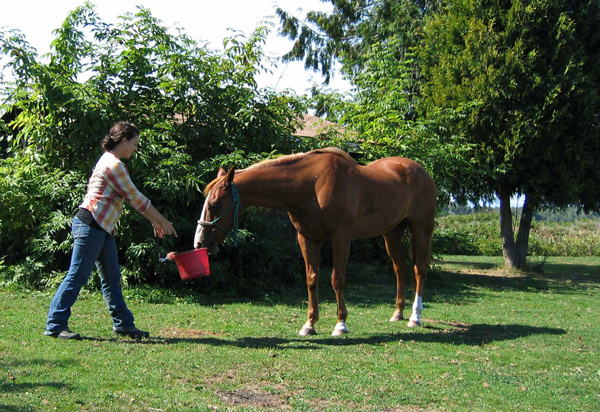 First we present the object.
Zuerst präsentieren wir das Objekt. |
- The progression of training commands might go like this – and in reality we train with many more tiny interim goals – so this description is a very shortened blog version!
- To proceed from „Touch!“ to „Fetch!“ we first hand him the bucket – but we only click, if he grabs it with his teeth!
- Then we shape the length of time he has to hold it (perhaps hand it to me), before I click…
- Then I don’t hand him the object anymore, but leave it on the ground, so he has to stretch out his neck for it…
- Then I increase the distance, so he has to take s step to approach it… and so on.
- NOW we are almost ready for our game! Let’s go and find something interesting!!
|
|
- Der Verlauf des Kommandotrainings sieht dann vielleicht so aus – und in Wirklichkeit üben wir mit noch viel mehr winzigen Zwischenschritten – diese Beschreibung ist für den Blog sehr gekürzt!!
- Um von „Touch!“ zum „Apport!“ zu gelangen, reichen wir ihm zuerst den Eimer an – aber wir klicken nur, wenn er ihn nicht mit den Zähnen packt!
- Dann arbeiten wir an der Zeitspanne, die er ihn halten muß (oder ihn mir vielleicht sogar anreichen muß), bevor er den Klick bekommt…
- Dann reiche ich das Objekt nicht mehr an, sondern lasse es am Boden, so daß er seinen Hals lang machen muß, um es zu erreichen…
- Dann vergrößere ich die Distanz, so daß er einen Annäherungsschritt tun muß… und so weiter.
- Jetzt sind wir fast für unser Spiel startbereit! Finden wir was Interessantes!!
|
 Umbrellas can be really scary! Not for these horses…
Schirme können traumatisch sein! Nicht für unsere Pferde…
|
- What can happen now is that your horse finds your interesting object merely scary. In the Blog series “Playing – with Knowledge!” you learned, which tasks are your responsibility as the leader, and in which way you must explain to your horse that there is no cause for worry. In this you must be convincing – read again from part 07 on of that Blog, because fear is never
fun!
|
|
- Was jetzt natürlich passieren kann, ist, daß Ihr Pferd Ihre interessanten Objekte beängstigend findet. In der Reihe „fachmännisch spielen“ haben Sie gelernt, welches Ihre Aufgaben als Anführer sind, und wie Sie dem Pferd verklauseln, daß es keinen Grund zur Unruhe gibt. Hier sollten Sie überzeugend sein – lesen Sie ab Teil 07 nochmals nach, denn Angst macht NIE Spaß!
|
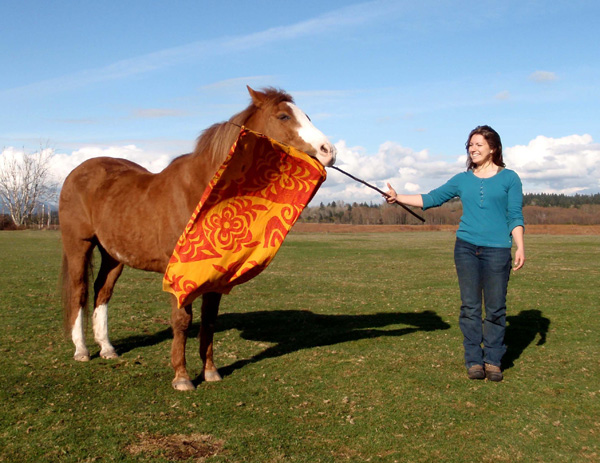 Dangerous flapping flags become toys!
Gefährliche Fahnen werden zu Spielzeug! |
- In the above mentioned series (part 11) we talked about “de-spooking” our horses and making them courageous. I cannot imagine ANY activity with my horses, which was as challenging, fun and rewarding both for me and the horses as this part.
|
|
- In der oben genannten Reihe (Teil 11) sprachen wir über „Ent-scheuen“ uund Ermutigung des Pferdes. Ich weiß keine andere Aktivität mit meinen Pferden, die soviel Spaß gemacht hat, so herausfordernd und so lohnend war, für uns alle – Mensch und Pferde!
|
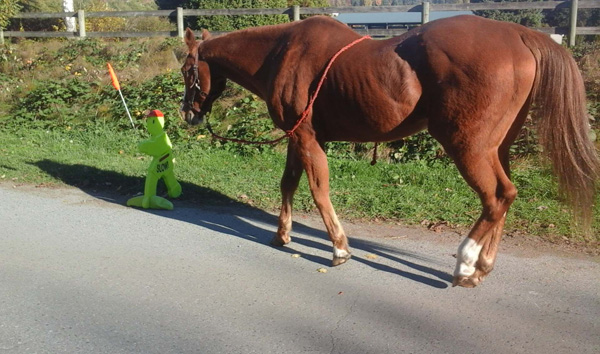 What might this be?
Was ist denn das? |
- Taking your horse for a walk, you get him interested in objects you find along the road by pointing to them and giving the command “fetch!”. Of course you watch your horse all the time and enthusiastically accept his proposals, if he shows you what is fascinating! Always re-inforce his curiosity, as this is a sign of him getting ever more courageous.
- Beau became extremely self-assured and explored by himself whatever new challenges appeared. The world was our playground and I am quite sure, he assumed that all road signs and so on were just put there for him.
|
|
- Auf Ihrem Spaziergang versuchen Sie nun Ihr Pferd für allerlei Gegenstände an der Straße zu interessieren, indem Sie drauf zeigen und „apport!“ sagen. Natürlich beobachten Sie Ihr Pferd die ganze Zeit und nehmen es begeistert an, sollte es Ihnen zeigen, was es faszinierend findet! Bestärken Sie immer seine Neugier, denn das macht es mutiger.
- Beau wurde unglaublich selbstsicher und erforschte ganz von sich aus was immer es da Neues zu sehen gab. Die Welt war unser Spielplatz und ich bin mir ganz sicher, daß er dachte, daß all die Verkehrszeichen usw. sowieso nur für ihn da aufgebaut waren.
|
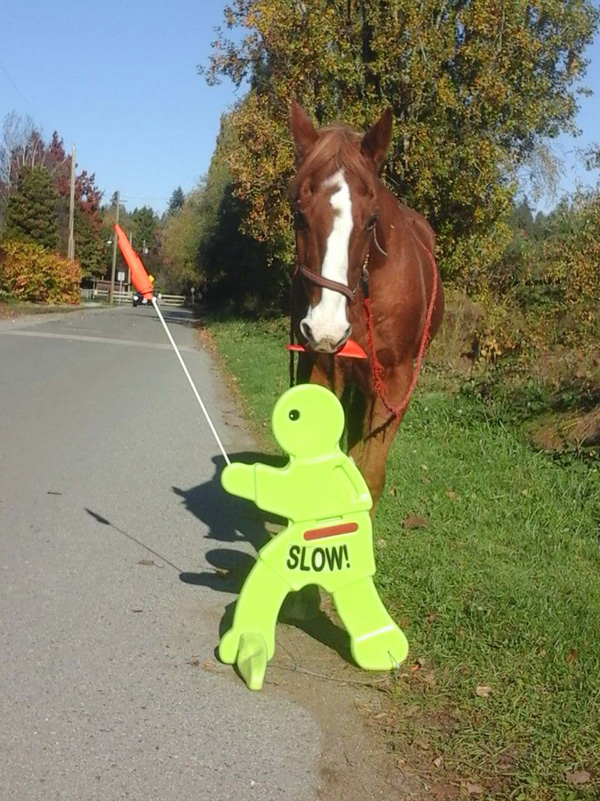 Got it !!
Ich hab ihn !!
|
- Now I request that he pay attention: I point to the hat of the yellow man and say “apport!” – first Beau fiddles around wildly, tips over the man and so on. Here again he has to go by the click – only when he hears that, has he found the right solution and gets his treat!
|
|
- Nun will ich, daß er aufpaßt: ich zeige auf den roten Hut des Gelblings und sage „apport!“ – Beau spielt herum, schmeißt den Gelbling um und was ihm sonst so einfällt. Wieder lernt er nur vom Klick – den hört er nur, wenn er die richtige Lösung gefunden hat, nur dann kommt die Belohnung!
|
 Tricky to get out – the flag is stuck hard.
Knifflig raus zu kriegen – das Ding steckt fest!
|
- Then I point to the flag – and that thing is tricky and only detaches with quite a strong tug at the right angle! Beau had to practice a while – it became his favourite exercise.
|
|
- Dann zeige ich auf den Wimpel – und das Ding ist knifflig und löst sich nur mit einem entschlossenen Ruck in der richtigen Richtung. Da mußte Beau ganz schön probieren – es wurde seine Lieblings-übung.
|
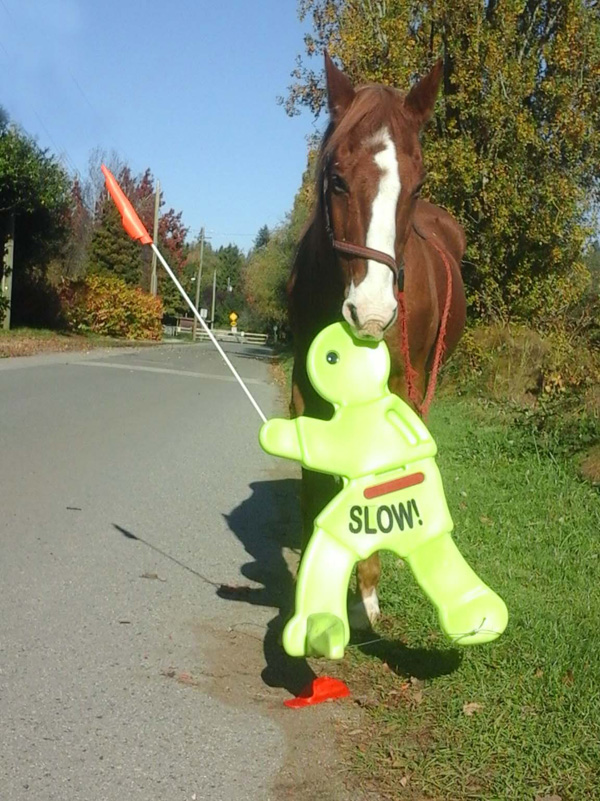 Darn the rules – let’s take the whole thing home!
Und bist du nicht willig… dann nehm ich das ganze Ding nach Hause!
|
- And if the flag didn’t come out as desired, he just took the whole thing home! That was Beau for you, never at a loss for a solution!
Keep on playing !!
|
|
- Und wenn der Wimpel nicht wie erwünscht abging, dann nahm Beau eben den ganzen Gelbling nach Hause! So war er – nie um eine Lösung verlegen!
Spielen sie weiter !!
|









